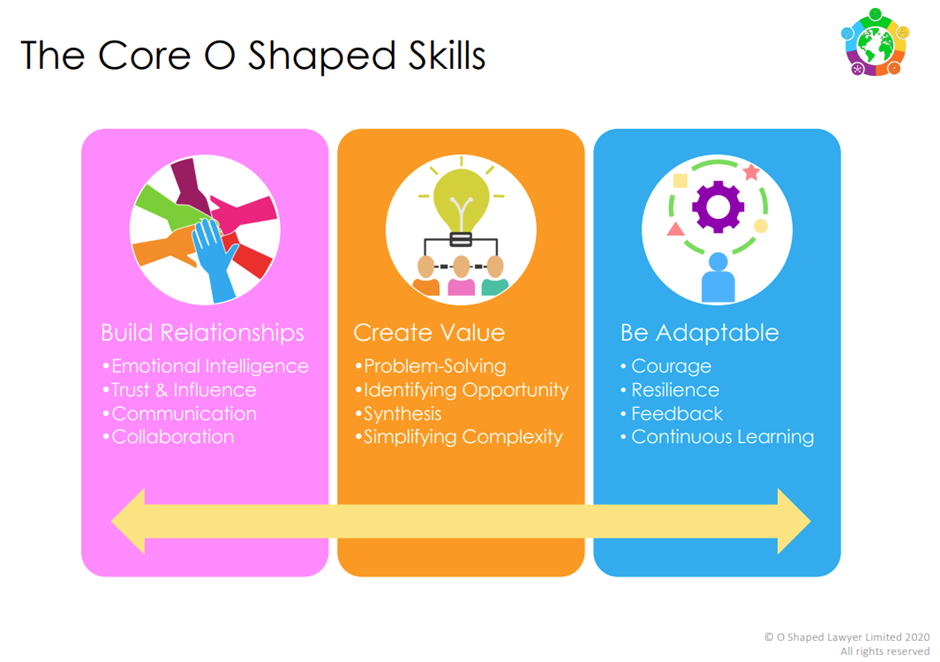Banner artwork by Bibadash / Shutterstock.com
The human-centered characteristics of different shaped lawyers
How many lawyers do you know who were, or still are, specialists in one narrow area. They have deep knowledge and expertise in this area but lack skills outside of this area. They are known as “I-shaped” lawyers. While this may have worked successfully in the past, the in-house landscape has changed and a successful lawyer is one who works collaboratively across the business and within the business, a business partner rather than an outside advisor. As the legal landscape has changed, so too have the models we can adapt to help us evolve.
This month, I consider the Delta Model, the T-shaped lawyer, and the O-shaped lawyer from the human-centric lens.
The Delta Model
The Delta Model is a competency model first created in 2018 by academics based on the idea of a T-shaped lawyer. It focused on technology, process improvement, and data analytics by emphasizing skills associated with emotional intelligence.
The current iteration (version 4) by Professors Cat Moon and Alyson Carrel renamed the three sides as The People, The Process, and The Practice and “removed any pre-defined list of skills allowing individuals and organizations to design customized Deltas that best reflect their unique values and priorities as well as any recent developments in the legal profession.”

The model is underpinned by:
- The Practice — Lawyers must start at a base of having deep legal knowledge.
- The Process — Lawyers must understand and appreciate the power of data, technology and process improvement.
- The People — Lawyers must continue to use emotional intelligence, communication, and collaboration to work with clients and colleagues.
Carrel described the model as:
- An agile competency model for the 21st-century legal professional that reflects and visualizes a more holistic set of knowledge and skills;
- Growing out of one version of the T-shaped lawyer; and
- Recognizing the skills related to the O-shaped lawyer — “A people first; then lawyers” approach, focusing on skills related to understanding and relating to our clients, our colleagues, and ourselves.”
Moon described the Delta Model on podcast, State Bar of Michigan on Balance Podcast on Legal Talk Network, as a “visual model that allows us to look at an array of competencies” whose goal is “to say these three areas are important, no matter what your role is in legal practice … the goal of the Delta Model really is to give every individual practicing lawyer the ability to design his or her own Delta, their own Delta, and understand this is the set of skills that I need to be working on in order to be successful and to thrive, so it’s able to be personalized for each individual person who chooses to use it as a tool.”
This model clearly allows lawyers to flexibly consider what it means for them to understand and relate to clients, colleagues, and themselves.
The T-shaped lawyer
Peter Connor first applied the T-shaped professional concept to lawyers almost 10 years ago at the same time as Amani Smathers and developed the idea of T-shaped lawyer beyond non-legal skills into a businessperson doing business work as well as legal work.

His first book describes what a T-shaped lawyer is and why become one and his second book explains how to become one using his T-Shaped Lawyer Framework™.

I spoke with Connor about his vision and framework. He emphasized that — “The mistake most are making is trying to decide what non-legal skills they need before being clear about what they will use them for — i.e., what work will you do now and moving forward?”Connor said that most non-legal skills are primarily for non-legal work.
Connor also highlights that it is “not all about skills (and not everything is a skill!) — Any professional development program has to cover skills, competencies, qualities, mindsets, and knowledge and these must be properly classified because the way you develop and use each is different.”
For example:
- Mindsets like The Businessperson Mindset™ should be adopted right away. Without that mindset, you might not identify an opportunity to use a skill like design thinking for the business.
- Skills like design thinking can be learned to a basic level quite quickly and can be used just for legal work— such as simplifying contract terms. However, it can, and should, also be used by lawyers for business work such as helping to solve complex business problems.
- Qualities like empathy can only be enhanced over time, and really only become useful for corporate lawyers in their work when used together with a skill such as design thinking.
- Acquiring knowledge of your client, or as I prefer your “customer,” takes time. It is useful for your legal work, but it becomes essential to do business work, and to develop and utilize a competency like innovation for the business and not just the legal department.”
Skills like design thinking can be learned to a basic level quite quickly and can be used just for legal work — such as simplifying contract terms. However, it can, and should, also be used by lawyers for business work such as helping to solve complex business problems.
The framework mindsets include Carol Dweck’s well known growth mindset which, in contrast with a fixed mindset, means that you believe that your abilities can be developed and are more likely to see effort as something that moves one towards learning and setbacks are opportunities to learn. For more on leading with a growth mindset, see my earlier article.

Connor came up with the Businessperson Mindset™ which in contrast with a “Just-A-Lawyer” mindset means someone who thinks of themselves as a businessperson and not just a lawyer considering things including:
- Being curious about the business and asking questions especially if something doesn’t make sense to you;
- Constantly thinking about ways to solve business problems and improve the business; and
- Learning more about the business including reading relevant internal communications and regularly speaking to colleagues in a range of functions.
By contrast someone with Just-A-Lawyer mindset will tend to focus only on doing traditional legal work, spotting legal issues, and advising on legal risk. They will not be generally curious about the business, only understand the business to the extent you need to for your work, and be too busy with legal work to find time to develop networks within your organization.
Connor says “adopting the Businessperson mindset, and enhancing your adaptability, requires lawyers to “let go” to some extent of your identity as a lawyer. One way to do that is to not wear your lawyer badge so prominently, especially when interacting with the business and functional executives at your company and try to fit in more as an equal member of the team that you support.”
I asked Connor if a lawyer needs to master all areas of the framework and he replied: “No, remember that a T-shaped lawyer is a version of what I call a “legal expert business generalist.” However, everyone should seek to develop a base level of understanding of all components of the framework and then focus your professional development on specific areas as outlined in my second book. The other thing that teams can do is ensure that, for every component of the framework, they develop at least one member who has a more advanced level of understanding and experience.”
The other thing that teams can do is ensure that, for every component of the framework, they develop at least one member who has a more advanced level of understanding and experience
Speaking of teams, Connor also mentioned that individual lawyers can transform to this new vision by using the framework as their “Lonely Planet style” guidebook without the support of their legal department. “However,” he said, “It is best if legal departments not only support this approach to individual professional development but also adopt the T-shaped lawyer at a team level. You can do that by utilizing his T-Shaped Team Framework™. This extends beyond professional development to change every aspect of a legal department and re-imagine or re-design the department.”
The O-shaped lawyer
The O-shaped lawyer was developed by Dan Kayne, when he was general counsel of regions for Network Rail UK. He is founder of O Shaped. The O-shaped lawyer is a well-rounded professional as opposed to a black-letter lawyer.
An O-shaped lawyer is guided by a specific framework outlining attitudes, mindsets, and behaviors through the pillars of optimism, ownership, open-minded, opportunistic, original.

The O Shaped Lawyer Competency Framework
The attributes show lawyers are positive and resilient. They are people focused on leading with more emotional intelligence at the heart of everything the lawyer does and working on building collaboration. If you want to build on some of these ideas, I have previously written on influencing outcomes with better communication, creative communications, and how positive emotions can open our minds.
An O-shaped lawyer is guided by a specific framework outlining attitudes, mindsets, and behaviors through the pillars of optimism, ownership, open-minded, opportunistic, original.

Under this model, a lawyer aims to reach a level of “outstanding” by exhibiting these skills:
- Emotional intelligence — serves as positive role models and visibly champion continuous learning, including by openly sharing and discussing their own learning and how they applied it;
- Trust and influence — able to build trusting relationships with others and effectively persuade peers, colleague and clients;
- Communication — legal advice is framed in a way that demonstrates understanding of the business context and lawyers consistently engage in client-centric communications;
- Collaboration — displaying collaborative behavior, have developed robust networks, and champion diversity of experience and background;
- Problem-solving — actively seeking to apply past problem-based learning by seeking opportunities to lead complex projects;
- Identifying opportunity — serve a positive role model by encouraging others to be client-focused in their work. Improving team performance by relying on innovation and creativity;
- Synthesis — teaching juniors to consider additional information and perspectives and supporting them in considering relevant content areas and data;
- Simplifying complexity — regularly distil key insights from complex information, serve as a positive role model by motivating others to do the same, and support others in strengthening their simplifying skills;
- Courage — accept, evaluate, and appropriately respond to critique and challenges by others (regardless of that person’s seniority), and take affirmative steps to help others create a psychologically safe environment;
- Resilience — championing a positive and healthy environment, teaching and supporting others, and openly sharing and discussing their own experiences with managing setbacks or challenges;
- Feedback — championing and participating in a feedback and coaching culture and are transparent about feedback they have received and how they implemented it; and
- Continuous learning — championing continuous learning, including by openly sharing and discussing their own learning and how they have applied it — and by teaching others to do the same.
What shape are you?
Each of these frameworks provides a blueprint for an individual to become more than “just a lawyer.” They are each designed to achieve different outcomes. Choosing one that resonates with you, and your objectives, will be the key to successfully making a lasting and impactful change to yourself as a lawyer and to your organization.
Disclaimer: the information in any resource collected in this virtual library should not be construed as legal advice or legal opinion on specific facts and should not be considered representative of the views of its authors, its sponsors, and/or ACC. These resources are not intended as a definitive statement on the subject addressed. Rather, they are intended to serve as a tool providing practical advice and references for the busy in-house practitioner and other readers.




